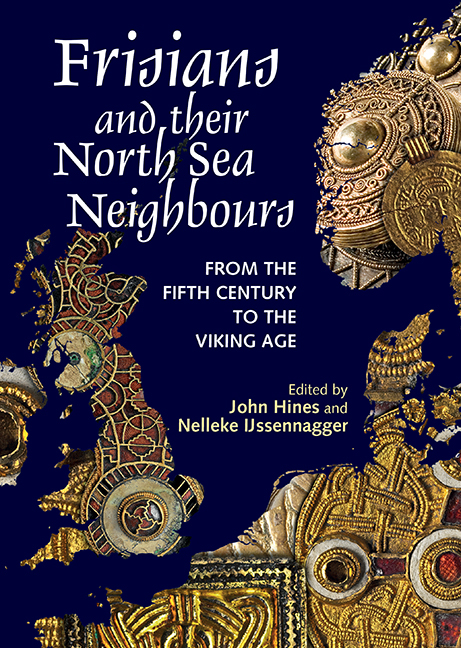Book contents
- Frontmatter
- Contents
- List of Figures
- List of Tables
- Preface
- Acknowledgements
- Linguistic Conventions and Abbreviations
- Abstracts
- Introduction: Frisians – Who, When, Where, Why?
- 1 Palaeogeography and People: Historical Frisians in an archaeological light
- 2 The Anglo-Frisian Question
- 3 Frisian between the Roman and the Early Medieval Periods: Language contact, Celts and Romans
- 4 ‘All quiet on the Western Front?’ The Western Netherlands and the ‘North Sea Culture’ in the Migration Period
- 5 Power and Identity in the Southern North Sea Area: The Migration and Merovingian Periods
- 6 How ‘English’ is the Early Frisian Runic Corpus? The evidence of sounds and forms
- 7 The Geography and Dialects of Old Saxon: River-basin communication networks and the distributional patterns of North Sea Germanic features in Old Saxon
- 8 Between Sievern and Gudendorf: Enclosed sites in the north-western Elbe–Weser triangle and their significance in respect of society, communication and migration during the Roman Iron Age and Migration Period
- 9 Cultural Convergence in a Maritime Context: Language and material culture as parallel phenomena in the early-medieval southern North Sea region
- 10 The Kingdom of East Anglia, Frisia and Continental Connections, c. ad 600–900
- 11 A Comparison of the Injury Tariffs in the Early Kentish and the Frisian Law Codes
- 12 Cultural Contacts between the Western Baltic, the North Sea Region and Scandinavia: Attributing runic finds to runic traditions and corpora of the Early Viking Age
- Index
12 - Cultural Contacts between the Western Baltic, the North Sea Region and Scandinavia: Attributing runic finds to runic traditions and corpora of the Early Viking Age
Published online by Cambridge University Press: 25 August 2018
- Frontmatter
- Contents
- List of Figures
- List of Tables
- Preface
- Acknowledgements
- Linguistic Conventions and Abbreviations
- Abstracts
- Introduction: Frisians – Who, When, Where, Why?
- 1 Palaeogeography and People: Historical Frisians in an archaeological light
- 2 The Anglo-Frisian Question
- 3 Frisian between the Roman and the Early Medieval Periods: Language contact, Celts and Romans
- 4 ‘All quiet on the Western Front?’ The Western Netherlands and the ‘North Sea Culture’ in the Migration Period
- 5 Power and Identity in the Southern North Sea Area: The Migration and Merovingian Periods
- 6 How ‘English’ is the Early Frisian Runic Corpus? The evidence of sounds and forms
- 7 The Geography and Dialects of Old Saxon: River-basin communication networks and the distributional patterns of North Sea Germanic features in Old Saxon
- 8 Between Sievern and Gudendorf: Enclosed sites in the north-western Elbe–Weser triangle and their significance in respect of society, communication and migration during the Roman Iron Age and Migration Period
- 9 Cultural Convergence in a Maritime Context: Language and material culture as parallel phenomena in the early-medieval southern North Sea region
- 10 The Kingdom of East Anglia, Frisia and Continental Connections, c. ad 600–900
- 11 A Comparison of the Injury Tariffs in the Early Kentish and the Frisian Law Codes
- 12 Cultural Contacts between the Western Baltic, the North Sea Region and Scandinavia: Attributing runic finds to runic traditions and corpora of the Early Viking Age
- Index
Summary
On the basis of the artefactual finds and structures, and based on contemporary or later written sources, early trading centres are generally conceived of as meeting places and melting pots of people from different cultures. A highly vivid sketch of the multicultural network of communication formed by the trading centres of a ‘Northern Arc’ ranging from the North Sea region to the eastern end of the Baltic and into Russia is drawn by Stéphane Lebecq (2007). In his overview, he touches on the exchange of goods from the 7th century through to the 9th, the different forms of economic enterprises in that period, and the impact of Viking expansionism. The jigsaw pieces of his panoramic picture are taken from chronicles, the historical accounts of Ohthere's and Wulfstan's voyages, and from archaeological excavations at the most prominent of these trading centres, including Dorestad, Hamwic, Ribe, Hedeby and Birka.
Interestingly, though, while drawing this picture, he never asks about the actual form of communication between the merchants and manufacturers coming from many different regions all over north-western Europe. This omission may be explained by the fact that, in most cases, neither the written sources which are drawn on to shed light on the political and religious history of these places nor the archaeological finds and structures provide any evidence of the languages and dialects spoken by the people living on these sites. The historical sources confine themselves to the most basic external information: thus Rimbert, describing the trading centre at Hedeby in his Vita Anskarii (ch. 24), only mentions ‘the great variety of people from all over the world’. Adam of Bremen offers more detail in his description of Birka (Gesta Hammaburgensis Ecclesiae Pontificum, I.60). He explicitly mentions Danes, Northmen, Slavs and people from Samland (on the Baltic coast). Helmold of Bosau names not only Slavs as inhabitants of the Baltic trading centre of Jumne/Jomsburg but also a ‘mixed population of Greeks and barbarians’, together with – as he calls them – ‘Saxons’ (Chronica Slavorum, II.22).
These selective references show that the historical sources usually only give names of groups, tribes or peoples, or even stereotypical group-labels, such as ‘barbarians’ as opposed to Greeks.
- Type
- Chapter
- Information
- Frisians and their North Sea NeighboursFrom the Fifth Century to the Viking Age, pp. 243 - 272Publisher: Boydell & BrewerPrint publication year: 2017



